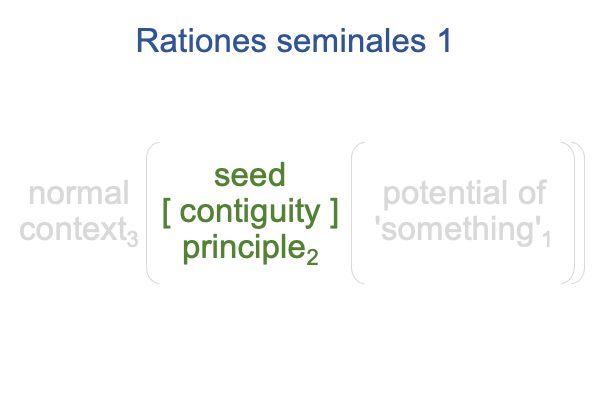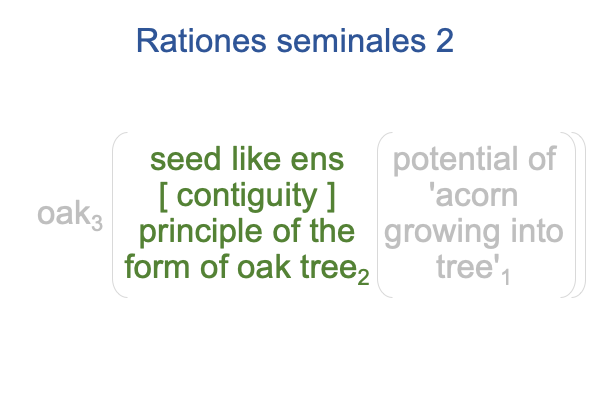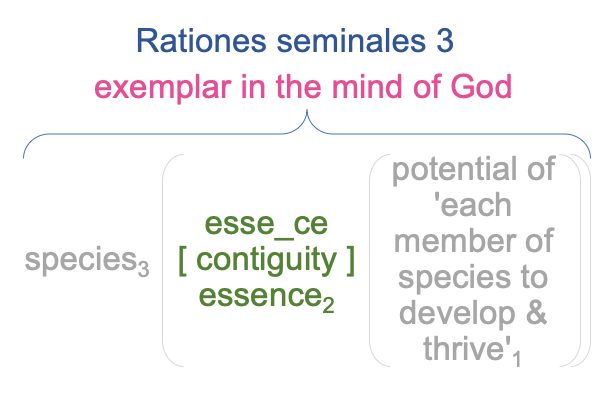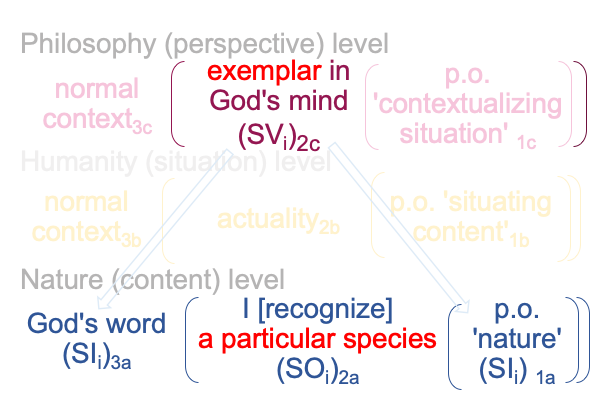0728 Chapter four of Theistic Evolution introduces Aquinas’s account of creation.
In this chapter, Tabaczek completely fills the plate with theologyagent (B1) material.
This is like eating an enormous meal.
We all know what happens 18 hours later.
This makes me wonder, “Is Tabaczek (B1) aiming to take an enormous crap on the mirror of science (C2)?”
And, is he going to name that steaming pile, “Evolution and Creation”?
Well, I cannot help thinking this as I sit down to dine on Aquinas’s account of creation.
0729 Oh, yes, the appetizer is delicious.
Tabaczek knows this material like the back of his hand.
Aquinas intends to cook Augustine’s proto-evolutionary concept of rationes seminales into a dish of intellectual sumptuousness.
0730 Rationes seminales?
“Rationes” translates as “principle”. “Seminales” translates as “seed”.
Of course, this technical term may be formulated as a hylomorphe. So, the term belongs to the realm of actuality.

0731 Augustine introduces the term in his commentary on Genesis 1 and 2, roughly titled On the Not Allegorical and More or Less Metaphorical Interpretation of Genesis.
Well, that is a long title.
Isn’t there a better word for “not allegorical and more or less metaphorical”?
How about the word, “literal”?
“Literal” makes for a shorter title, for sure.
So, let me call Augustine’s book, “On the Literal Interpretation of Genesis”.
0732 In order to understand the term, rationes seminales, I put it2 in a category-based nested form.
0733 Right away, I think of the normal context of an oak. I can compare an acorn to an oak tree?
Well, an acorn exemplifies a seed.
But, does a tree exemplify a principle, in the same way that a tree manifests a form?
Okay, what if Augustine’s “seed” is not an acorn?
Then, it may be a metaphor for what an acorn does.
An acorn germinates and knits together a tree.
0734 This brings me to a difficult topic, because the seed does not correspond to matter, in the same way that bronze corresponds to matter when the form is a statue. The seed represents a relational being that entangles matter… or realness… in the process of substantiating a form.
The Latin word for “being itself” is ens. The Latin term for “matter substantiating” is esse.
It makes me wonder whether there is a Latin word for “being substantiating”, where being, ens, is purely relational, or relational with a small entanglement of matter?
Hmmm. The Latin term is still esse.
0735 Well, that is good enough for me.
Here is my metaphor for rationes seminales as an actuality in a nested form.

The seed, “seminales“, reminds me of the way DNA gives rise to a phenotype. It is primarily a relational structure, a “code” to the geneticist, that makes that particular normal context3 exclusive. This association implies that each species of tree contains its own seed. Plus, the seed gives a species its esse_ce.
The principle, “rationes“, reminds me of the way that a living form adapts to an actuality independent of the adapting species. It is like an idea that solves a problem. The challenge is either dangerous (like a predator) or beneficial (like the nectar of a flower). To the extent that the idea works, the species thrives. “Rationes” gives a species its essence.
0736 So, now I make a substitution that translates Augustine’s term into a seemingly more familiar (yet really unfamiliar) hylomorphe. This hylomorphe is not the contiguity between matter and form. This hylomorphe is a metaphorical actuality. After all, if esse_ce is matter [substantiating] and essence is [substantiating] form, then what would be the contiguity between esse_ce and essence?
Would it be a substance within substance?

0737 When Tabaczek discusses the idea of exemplars in the mind of God, each animal or plant is a manifestation of an exemplar. Augustine’s notion of rationes seminales applies.
How so?
Rationes seminales enters into the exemplar as esse_ce [contiguity] essence2 in the normal context of each species3 and the potential that each member of the species is capable of developing (due to DNA) and thriving (due to its suitability for the environment of evolutionary adaptation or an AIAS)1.
0738 On top of that, the interventional sign-relation allows me to depict how my recognition of a particular species2aserves as a sign-object (SOi) that testifies to a sign-vehicle (SVi), the corresponding exemplar in the mind of God2c.
The following figure appears in the section on Interscopes and Sign-Relations (points 0335-0425).

